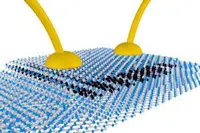 Research by University of Manchester scientists is said to have made 'dozens' of 2D materials with unusual properties available to those developing new products.
Research by University of Manchester scientists is said to have made 'dozens' of 2D materials with unusual properties available to those developing new products.
According to the team, the problem has been that most 2D materials are unstable in air, so react and decompose before their properties can be determined.
However, by protecting the new reactive crystals with more stable 2D materials, such as graphene, via computer control in a specially designed inert gas chamber environments, these materials can be successfully isolated to a single atomic layer.
The team, led by Dr Roman Gorbachev, used its fabrication method to study two 2D crystals that have generated intense scientific interest in the past 12 months but are unstable in air – black phosphorus and niobium diselenide.
Dr Gorbachev said: "This is an important breakthrough in the area of 2D materials research, as it allows us to dramatically increase the variety of materials that we can experiment with using our expanding 2D crystal toolbox."
It is believed that, by combining a range of 2D materials in stacks, scientists will be able to create 'materials to order' to meet the demands of industry.
High frequency electronics for satellite communications and light weight batteries for mobile energy storage are two application areas that may benefit from this research.
Author
Graham Pitcher
Source: www.newelectronics.co.uk

